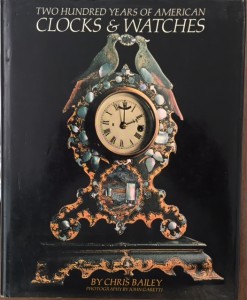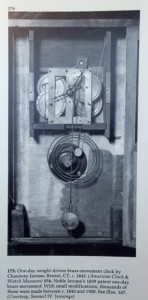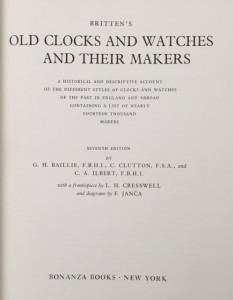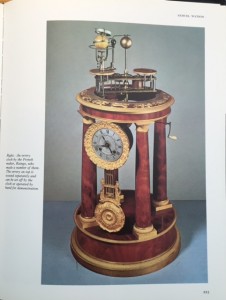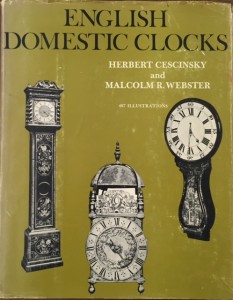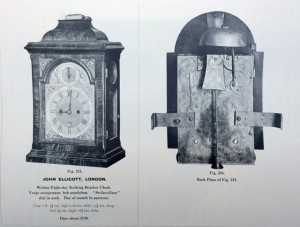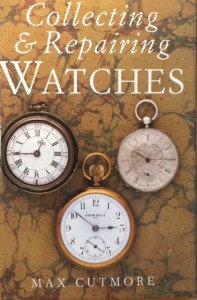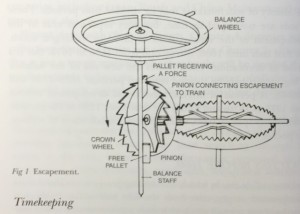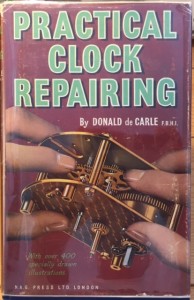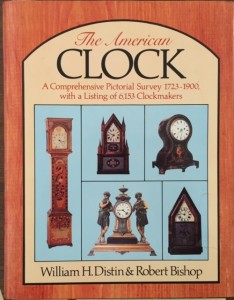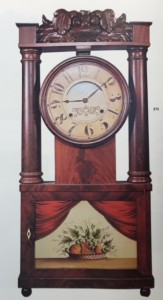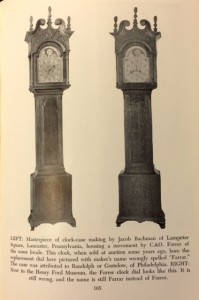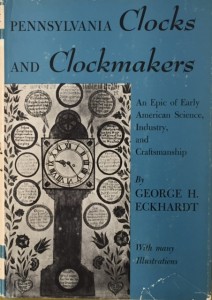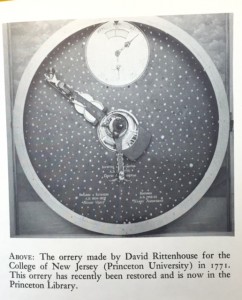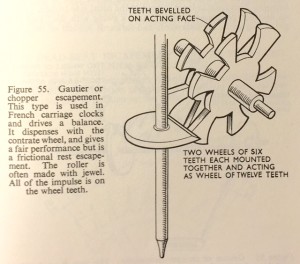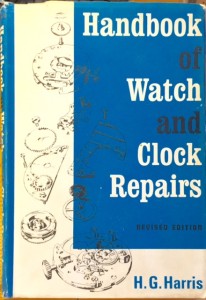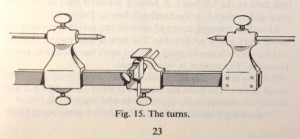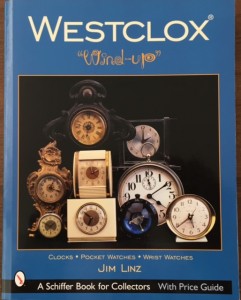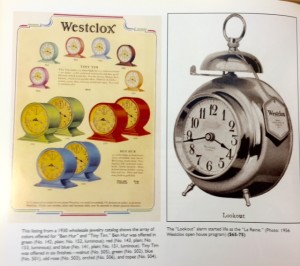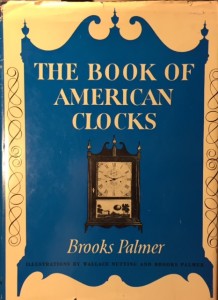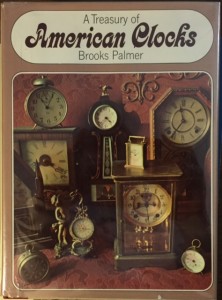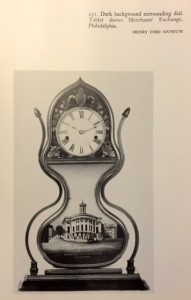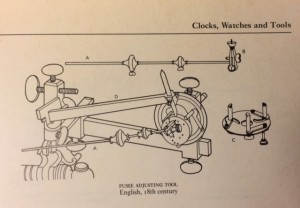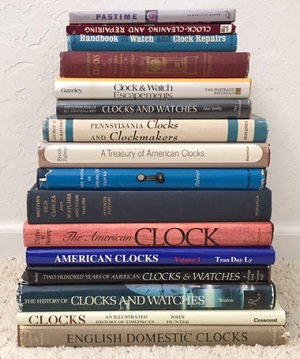
My little collection of clock and watch books.
For people interested in the history or collecting mechanical clocks and watches, there is no better source of information than printed books on the subject. Just as mechanical clocks have become a relic of the past, so have the many books written as historical reference guides also diminished in availability. Over the years I’ve collected several books on clocks and watches that I found as interesting as the mechanical instruments themselves.
My little collection of clock and watch books
My little library is not an authoritative collection. It definitely leans towards providing more information about American clocks, the subject of which I was most interested in a collecting and historical perspective. Most of my clock books were originally printed in the 1940’s and 1950’s and many are revised editions of the originals. As opposed to clock books published in the 1980’s that are more coffee table books with beautiful pictures of the timepieces, the older books have more historical and technical information contained within them.
Old books and old clocks are becoming scarce
Excellent clock books are still being produced today such as the Westclox Wind-up by Jim Linz. But there is something about the older clock and watch books that are special. It could be the narration with the special reverence to the old clock masters and a perspective that mechanical timepieces could never be replaced by battery operated clocks and watches. Unfortunately, we know the rest of that story.
List of old clock books collected
Below are some of the clock and watch books from my collection that I value most. They range from very technical to pure reference for the identification of a wide array of clock and watch types. I found most at used, rare, and antique book stores and a few from watch and clock club I belonged to. From my experience these books are becoming scarcer at retail outlets, but I’m sure many of them are available on the Internet.
In order of the first authors last name.
| Two Hundred Years of American Clocks & Watches |
| Bailey, Chris |
| 1975, Prentice-Hall, Inc., N.J. |
| Library of Congress Catalog Card Number 75-13714 |
| ISBN: 0-13-935-130-2 |
254 pages
This book is broken into two main parts- the age of handcrafting and the age of manufacturing. The author reviews various clockmakers by region or colony when each clock was made entirely by hand. The book discusses the subtle differences between the different schools of design and construction loosely associated with each region. When mass production of clock parts becomes a reality after about 1800, the book then focuses on specific types of clocks and manufacturers. There is also a small section on watches made in America from 1800 to 1970. The main emphasis for this section is on pocket watches.
From the foreword, “The reader will find the history of American clock and watchmaking filled with men of ingenuity and perseverance in a constant struggle for economic survival. Some businesses lasted for a considerable time; many did not. But he efforts of these men, however lengthy or brief, resulted in the manufacture of hundreds of millions of clocks and watches. Some of these timepieces were made for the wealthy, but not all. Perhaps the greatest contribution of American horology to the industry was the manufacture of timekeeping devices at a cost so low that they could be purchased by almost anyone.”
| Britten’s Old Clocks And Watches And Their Makers |
| Baillie, Clutton, and Ilbert |
| 1956, Crown Publishers, Inc., N.Y. |
| Original publication 1894 |
518 pages
Over 10,000 known clock and watch makers are listed in the Britten index. Some entries are as short as the name, city of residence and date of death. Other clock or watch makers where they studied, apprenticeships, the cities and countries where they worked, the types of clocks or watches they made. There is a nice glossary of technical terms and a list of Hall-marks and their icons. There is a section of short biographies of famous makers. The first part of the book is dedicated to the history of the various types of timekeepers from tower clocks to watches.
Chapters and sections include Counting the Hours, Age of Decoration (lantern, table, coach clocks), The Guilds, Counting the Minutes (development of the pendulum and balance spring), English Supremacy (long-case, bracket clocks, watches), Counting the Seconds (watch mechanisms, escapements, marine chronometer), French Clocks, National Styles, and Alarum, Striking and Repeating Mechanisms.
From Editor’s preface to the Seventh Edition, “Firstly, that ‘Britten’ has become the ‘bible of the amateur collector and professional dealer. They are most interested in instruments of a kind likely to pass through their hands. Except insofar as they may provide some essential link in the historical sequence of events, unique examples are not of such great interest to the average collector and dealer, and this premise has largely guided the choice of illustrations. Similarly, the more unusual and complicated forms of mechanism have not been described in detail and the diagrams have been confined to typical examples. In these, and their explanatory captions, the aim has been to produce something which would be understood readily by the average collector, rather than precise accuracy of terminology and draughtsmanship.”
| The History of Clocks and Watches |
| Bruton, Eric |
| 1979, Rizzoli International Publications, Inc. N.Y. |
| Library of Congress Catalog Card Number 79-65958 |
| ISBN 0-8478-0261-2 |
288 pages
This is a nicely illustrated book with lots of colored photographs documenting the history of timekeeping. It does a nice job of capturing the intricacy and artistry of early watches. It also highlights the technological advancements of pendulums and escapements to perfect mechanical timekeeping.
Chapters include Earliest Clocks, Advent of Clockwork, Domestic Clocks, European Mechanical Clocks, Time at Sea, Development of the Watch, Mass Production, The Technological Age, The Science of Time, and Great Clocks of the World.
From the introduction, “The search for perfect timekeeping is one of the most inspiring stories of man’s brilliance of mind and skill of hand. It takes us from the cave dweller in a primeval forest who relied upon the working of the biological clocks of animals he hunted to trap them for food; to the ancient and skilled art of the shadow clock; to the priests who constructed the calendar and the astrologer who controlled monarchs by time predictions; to the long and close association of astronomers with clockmakers; to the instance effort to use clocks for navigation at sea; to the great cathedral clocks and models of the universe; to the domestic clock, the watch and the ultimately quartz crystal and atomic timekeepers that showed Earth itself to be a poor and erratic timekeeper.”
| English Domestic Clocks |
| Cescinsky, Herbert and Webster, Malcolm R. |
| 1968, Crown Publishers, Inc., U.S. |
354 pages
The oversized and decorative first letter of each chapter, coupled with the large text and line spacing give the reader the feeling there are reading ancient monastic text printed on parchment. And I suppose that is what the authors were hoping for. Devoted solely to the construction and manufacture of English long case and bracket clocks, the book is filled with excellent photography and illustrations. Since the English Domestic Clocks was inspired by a previous history book on English furniture, ample attention is given to the intricate and ornate clock cabinets. Until mass production of clocks became the norm, most tall case clocks were composed of a clock movement made by one person and the cabinet by another.
Chapters include The Measurement of Time, Law of the Pendulum, Regulation of Domestic Clocks, Mechanism of Clocks, Brass Lantern or Birdcage Clocks, Development of Long Case Dials, Development of Clock Hands, Development of Spandrel-Corners of Clock Dials, Long-Case Clocks 1670 to 1740, Lacquered Cases of Long Clocks, Long-Case Clocks 1760 to 1800, Decline of Long-Case Clocks, Chippendale and Sheraton Clock Cases, Bracket Clocks 1670 to 1800, and Mural and Cartel Clocks.
From the preface, “An attempt has been made in this book to systematize the subject of English domestic clocks, and to avoid thereby, as far as possible, the discursiveness so common in books dealing with the technical side of our national hadndicrafts. If the volume does no more than to present, in interesting and readable form, the history of the development of perhaps the most characteristic of our national industries of the later seventeenth and the whole of the eighteenth centuries, and to promote an intelligent interest in the finer examples of the art of the cabinetmaker and the inventive ability of the clockmaker, and it is hardly fair to the latter to consider his production merely as more or less decorative pieces of furniture, especially as many of the more notable examples are characterised by the extreme simplicity of their cases.”
| Pastime, Telling Time from 1879 to 1969 |
| Collins, Phillip |
| 1993, Chronicle Books, S.F. |
| ISBN: 0-8118-0278-7 |
95 pages
Pastime is a double entendre referring to clocks that are past their time fashion and that collecting these novelty clocks is a pastime for many people. This small little book centers on all those funky little novelty clocks that are casually discarded when they stop working but can have real historical value. The nickel windup clocks from the late 19th and early 20th century have various automated scenes as the clock ticks and tocks. African Americans images were popular such as a washer woman or a black man’s eyes darting back and forth. These are also clocks representing the industrial and modern age with new plastic cases or atomic age designs.
Chapters include significant novelty clocks from the 1920’s, 1930’s, 1940’s, 1950’s and 1960’s.
From the introduction, “In this century, many clocks continue to reflect society’s cultural values and scientific expertise. Some may represent simply the eccentric aesthetic taste of their maker. Others-such as the sample in this book –have become prized by collectors. Valued collectible clocks are the focus of Pastime, in which the reader will find a wonderful selection of interesting clocks, man fashioned in the four decades following World War I, and each possessed of a value beyond its simple mechanical ability to keep track of the hours, minutes, and seconds of our days.”
| Collecting and Repairing Watches |
| Cutmore, Max |
| 1999, David & Charles, U.K. |
| Original publication 1976 |
| ISBN 0 7153 0819 X |
191 pages
This is an updated version of the 1976 book by Cutmore “The Watch Collector’s Handbook”. The heart of any watch or clock is the escapement mechanism that allows either the wound spring or weights to release their stored motive power to drive the gear train at a speed so that hands can indicate the correct time of day on the watch dial or clock face. This book gives a nice overview of the different escapements employed as watches shrunk in size. It is a nice primer but not a reference book about the variety of different watches made over the centuries.
Chapters included Historical Survey, Technical Survey, Watch Making, Collecting, Repairing, Hallmarks, Watch Sizes, and a technical glossary.
From the introduction, “What does this book offer the reader? In the first chapter there is an outline of the history of watches from c.1550 to the present day. The second chapter looks at the technical developments in escapements and timekeeping during the same period; this includes a simple discussion of the electronic watch. Then a completely new third chapter discusses the changing watch manufacturing techniques after 1700 in France, Switzerland, America and England, and provides information on the newer watchmaking countries, including Japan, Russia and China.”
| Practical Clock Repairing |
| de Carle, Donald |
| 1968, N.A.G. Press, Ltd, London |
| Original publication 1952 |
244 pages
As the title implies, this book focuses on the basics of clock repair. The author addresses a variety of different movements, all primarily English in making. The book discusses certain aspects of clock repair that can really hang up novices such how pinion leaves mesh with wheel gear teeth. The author doesn’t shy away from including the necessary mathematics and geometry so important to making the clock movements run correctly.
Chapters include Workshop and Bench, Examining the Movement, Dismantling and Repair, Cleaning and Reassembly, Gearing Calculations, Striking Clocks, Chiming Clocks, Pendulum, Fusee Timepiece Pendulum, Making a Fusee Timepiece, French Clocks, Carriage Clock Escapements, English Fusee Bracket Clocks, Weight-Driven Antique Clocks, Alarm Clocks, and 400-Day German Clocks.
From the preface, “I have described processes and operation in minute detail because I am sure that although some readers may be impatient of such lavish description and illustration, the big majority, particularly among the apprentices, will prefer to see it all in black and white with no knowledge assumed and nothing left to change.”
| The American Clock |
| Distin, William H. and Bishop, Robert |
| 1983, Crown Publishers, Inc., N.Y. |
| Original publication 1976 |
| Library of Congress Catalog Card Number 83-6058 |
| ISBN: 0-517-413590 |
359 pages
The photography, which is usually lacking in most clock identification books, is quite good in this volume. The color photographs along with the black and white images are professionally done. And since this is primarily a book to help collectors identify clocks, good images are appreciated. There is even a nice pictorial reference of clock and watch making tools. Included is a list of American clockmakers and glossary of terms.
Chapters include Tower Clocks, Tall Case Clocks, Dwarf Case Clocks, Bracket Clocks, Massachusetts Shelf Clocks, Lighthouse Clocks, Calendar Clocks, Novelty Clocks, Tools, Wall Clocks, Banjo and Lyre Clocks, Girandole Clocks, and New Hampshire Mirror Clocks.
From the introduction, “We must make it clear from the beginning that it has not been our intent to produce a history of clockmaking in America; such books are already available and will be found listed in the selected bibliography included at the end of this volume. Instead, we have consciously brought together a very large number of photographs of significant clocks of all types so that collectors will have in this volume a substantial pictorial reference with which to compare the clocks already in their collections or to check the points of a clock to be acquired. Each clock illustrated is identified by its generally type, the kind of movement, the maker (where known), his location, and the approximate date when the clock was made. The height of each clock is also given an additional factor from proper identification.”
| American Clocks & Clockmakers |
| Dreppard, Carl W. |
| 1947, Doubleday & Company, Inc., N.Y. |
363 pages
This book is a moderately detailed historical accounting of mechanical clock manufacturing in America. While the thirty pages of black and white photos of early American clocks are great, the reproduced illustrations of the clocks look like bad photo copies. There is a ninety page alphabetical listing of known American clock makers, the city they worked in, and the time period they were producing clocks.
“Names of clockmakers (or any other artisans for that matter) derive from one or more of the following data sources; (1) Work of record – in this case actual clocks, bearing name of maker on dial, frequently the place of making, infrequently the date or a number and, on even rarer occasions (save in the case of factory-made clocks), a paper pasted inside the case giving maker’s name, sometimes the name of the printer of the paper or label, and at times the label of the maker of the case.” – page 193
| Pennsylvania Clocks and Clockmakers |
| Eckhardt, George H. |
| 1955, The Devin-Adair Company |
| Library of Congress Catalog Card Number 55-7743 |
229 pages
This book is dedicated to the clocks and the men who made them in Pennsylvania. The book has an index of clockmakers specific to Philadelphia and a separate index for those craftsmen outside of the city. This is not a pure history book as text is given to escapements and the equation for determining the oscillation of a pendulum. In addition of fine illustrations of clock movements, the author also includes the musical score of the song “Grandfather’s Clock” by Henry Work, for which the tall case clock received the title of the same. There is also a brief description of famous clockmaker David Rittenhouse.
Chapters include The Pennsylvania Clock, The Dial of Ahaz, Clockmakers of Pennsylvania, Almanac Built in a Clock, Repair and Restoration, Pennsylvania-German Folk Art, Grandfather’s Clock, Watchemakers and Watchpapers of Pennsylvania, Clocks and Bells of the State House, Christian Huygens: Horolgium, and William Molyneux: Astronomical Equation of Time.
From the foreword, “Practically all Pennsylvania clocks were of the weight-and-pendulum type in a tall case – now know[n] as the “grandfather’s clock.” …For more than a century and a half, from 1682 to 1850, there were few, if any, innovations in basic design, yet each Pennsylvania clock was an individual creation, and it may be said that no two are exactly alike. Colonial cabinet makers often lavished their best craftsmanship on clock cases. Some of these, in Pennsylvania, represent the finest example of cabinet work of their respect periods.”
| Clock and Watch Escapements |
| Gazeley, W.J. |
| 1982, Van Nostrand Reinhold Company, N.Y. |
| Original publication 1956 |
| Library of Congress Catalog Card Number 81-52774 |
| ISBN 0 442 22892 9 |
294 pages
More of an encyclopedia, this book focuses on the regulating mechanism behind the timekeeping of all clocks and watches. Originally published in 1956 this reprint has excellent line drawings of a variety of different escapements that are as interesting to look at as they are to visualize in action. Written by a much respected clock repairman in England the author discusses the escapements from the perspective of putting them back into working order.
Chapters include Part 1 Clock Escapements – Verge or Crown Wheel, Recoil, Dead-beat, Gravity, Chronometer Dead-beat, and Platforms. Part 2 Watch Escapements – Verge, Mudge, Remontoire, Cylinder, Virgule, Duplex, Lever, Chronometer, Depth Tool, Polishing.
From the preface, “Some escapements described are no longer fitted in new clocks and watches, but many are still in use and will require repair from time to time, and as there is very little literature available on the subject this book seeks to provide the necessary information. It is also hoped that the reader’s interest will be aroused b the detailed descriptions of these old escapements as well as their failings.”
| Handbook of Watch and Clock Repairs |
| Harris, H.G. |
| 1975, revised, Emerson Books Inc. |
| Original publication 1961 |
| Library of Congress Catalog Card Number 63-9747 |
176 pages
Contains general sections on workbench and tools, materials and use of hand powered turn; a substitute for a lathe. One section addresses the escapements found in watches and another in clocks. It is a good overview with very good exploded diagrams of the different movements the author discusses. The book is a nice primer or introduction to watch and clock repair. It is not specific to a particular manufacturer.
Chapters include Part 1: Workbench and tools, Materials, The turns and their uses. Part 2: Watches, The movement, Overhauling and cleaning,, Wheel trains, Hands, dial and motion works, Keyless work, Barrels, mainsprings and fusee chains, Escapements, Balances, Shock Proofing, Cases, Magnetism. Part 3 Clocks, The movement, Pendulum clocks, Striking clocks, Chiming clocks, Grandfather clocks, Carriage clocks, Cuckoo clocks, French clocks, Alarm clocks, Electric clocks.
Harris writes, “In writing this book, I have assumed that the reader has no knowledge of the subject and I have endeavored, therefore, to concentrate on the basic principles rather than advance work. An attempt has been made to show the beginner that quite a lot of practical work can be one with limited equipment and small initial outlay.”
| Clocks An Illustrated History of Timepieces |
| Hunter, John |
| 1991, Crescent Books, N.Y. |
| ISBN: 0-517-05239-3 |
160 pages
As is the case with clock books produced in the late part of the 20th century, the images are much better than clock books produced in the 1950’s. While this book is not a bible or encyclopedia of clocks, it is a nice short course with a nice presentation. It gives a good introduction to the lantern clock, one of the first compact timekeepers in the U.K., and the author includes a brief mention of the French Comtoise or Morbier clock. Even though some of the novelty clocks did not advance the science of clock making, this book has nice pictures of the Ansonia swinging ball mystery clocks and a Viennese automaton picture clock. There is also a section devoted to pocket and wrist watches.
Chapters include The Lantern, Long Cases Search for Precision, Bracket, Mantel and Shelf Clocks, France and the Decorative Arts, Germany and the Black Forest, Wall Clocks, Skeleton Clocks, Novelty Clocks, Watches, and The Electric Revolution.
From the Introduction, “This present book makes no attempt to five details of the life histories of more than one or two of the most important and influential clockmakers of the past. It summarizes the evolution of the mechanical clock from the crude ecclesiastical timekeepers of the fourteenth century Europe to the sophisticated and complicated mechanical clocks and wristwatches still being manufactured in Switzerland and elsewhere today. It also discusses the major domestic clock types which have been developed over the past three centuries and shows where they fit in the rich tapestry of mechanical horology.”
| Westclox Wind-up |
| Linz, Jim |
| 2004, Schiffer Publishing Ltd. |
| ISBN 0-7643-1911-6 |
256 pages
This book recounts the history of the United Clock Company, predecessor of the Western Clock Company, and the affordable, mass produced clocks for the growing middle class families in America. A large focus of the book is given to the development of the Big Ben and Baby Ben clock movements and designs. Westclox Wind-Up is much an homage to indestructible and unique clocks made by Western Clock as it is a history and reference book. There is also a short section on Westclox pocket and wrist watches.
Chapters included Advertising and Marketing of Westclox, Innovations in Spring Wound Timekeeping, Selected Designs and Designers, Big Ben and Baby Ben Family of clocks, Pocket Ben and Wrist Ben, Index of Model Names and Numbers.
From the introduction, “This book traces the history of the Western Clock Company through the pages of Tick Talk, the award-winning employee magazine launched in May 1913 to promote worker-company relations. In addition to news of new product introduction and advertising, Tick Talk informed employees of new benefits, upcoming vacations, and changes in work hours. It constantly stressed the importance of safety, both at the t plant and away from work.”
| The Book of American Clocks |
| Palmer, Brooks |
| 1977, Macmillan Publishing, N.Y. |
| Original publication 1928 |
| ISBN 0-02-594590-4 |
318 pages
The first half of the book is dedicated to black and white photographs of early American clocks and some watches. The second half of the book is a list of known clock and watch makers, they timeframe in which the were making clocks, location and general type of clocks manufactured. In addition to short history of clock making in America, the book discusses broad classifications of clocks such as dwarf tall clocks, shelf clocks, and American watches. There is also a glossary of terms provided.
From the introduction, “What has been attempted in this book is to establish the known background of clock and watch making in America; to show, by means of illustrations, the development of the more important types of clocks and watches; and to provide a list of makers with as much information about them as is currently obtainable. Particular attention has been paid in the illustrations to clock movements, because what is inside the clock case is as least as important in dating a clock as the case itself. It is hoped that by careful examination of the list and the illustrations, any American clock or watch can be identified as to its date and its maker.”
| A Treasury of American Clocks |
| Palmer, Brooks |
| 1974, Macmillan Publishing |
| Originally published 1967 |
| Library of Congress Catalog Card Number: 67-28469 |
371 pages
This Palmer book is a little more egalitarian as he includes more examples of the uniquely mass produced early clocks such as the wooden movements of the pillar and scroll clocks. Early American clock makers didn’t have easy access to brass so they improvised using wood for plates and some gears. This book includes pictures of the more popular mass produced clocks of the early 19th century such as the Steeple and OG clocks. Various newspaper advertisements are included in this book along with a section on a variety of windup and battery powered nightstand alarm clocks.
Chapters include Grandfather and Grandmother Clocks, Massachusetts Shelf Clocks, Banjo, Girandole, Lyre, Lighthouse, New Hampshire Mirror, Edward Howard, Tower, Benjamin Franklin’s Clock, Pillar & Scroll, Looking Glass & Transition, Silas Hoadley, Wagon Spring, OG, Steeple, Bee Hive, Acorn, Silas Burnham Terry, Labels & Advertisements, Clocks of New York State, Connecticut Shelf, Mother of Pearl, Cottage, Calendar, Novelties, Alarms, and museums.
From the foreword, “Brooks Palmer’s A Treasury of American Clocks, which complements his The Book of American Clocks, published in 1950, represents a landmark in the pictorial history of American craftsmanship. The interval of nearly twenty years between the publication of the two book has been dictated by the author’s continuing research and his insistence on reproducing the most outstanding examples of the clockmaker’s art. The illustrations in this book, with their accompanying captions, show the development through more than two centuries of the American cock and timepiece, from the early grandfather clock through windup alarms and electric timepieces.”
| The Connoisseur Illustrated Guides Clocks & Watches |
| Smith, Alan |
| 1975, The Connoisseur Chestergate House, London |
| ISBN 0 90030 508 8 |
222 pages
This book is filled with wonderful illustrations and nice photography. It is part English clock and watch history combined with some basic fundamentals of the various types of escapements and movements The book touches on all the major clock developments and styles leaning toward the more unique and intricate designs.
Chapters include – Clocks, Watches and Tools, Mechanical Clocks before 1550, Early Renaissance Clocks and Watches (1550 – 1650), Classical English Horology, English Rococo and Neo-Classicism, English Eclecticism, American Clocks and Watches, Continental Europe and Japan, Modern Clocks and Watches.
From the introduction, “To attempt to produce a book about the clocks and watches of the past five hundred years, taking English clock and watchmaking as the most important of it but also devoting a considerable amount of space to the products of other European countries and America, has meant looking at the whole problem from a bird’s eye view, bearing in mind what has already been written and trying to decide what would be most useful for the students and collectors of today.”
Let me know if I missed collecting one of your favorite clock or watch books.


